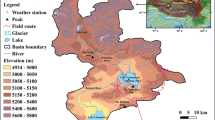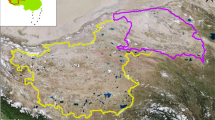Abstract
To study the response of lakes to climate change, variations in volume of closed lakes larger than 50 km2 on the Tibetan Plateau (TP) were analyzed by integrating Shuttle Radar Topography Mission, Digital Elevation Model (SRTM DEM) and LANDSAT images. Total lake volume (LV) increased (net) by 102.64 km3 during 1976–2013 with an average annual rate of 2.77 km3 year−1; the rate increased dramatically to 7.67 km3 year−1 during 2000–2013. Four main patterns of LV change were discovered using k-means clustering analysis: (1) a slight increase in LV during 1976–2000 followed by a rapid increase in the southeastern part of the endorheic region, (2) an initial decrease in LV followed by an increase during 1990–2013 in the central and western parts of the endorheic region, (3) an initial decrease in LV followed by an increase during 2000–2013 in the northeastern part of the endorheic region, and (4) an overall decrease during the whole study period for the southern outflow region. Precipitation was the dominant factor affecting LV change. In particular, abnormally large amounts of precipitation during 2000–2013 resulted in a dramatic increase in LV. Temperature changes were positively correlated to LV change before 2000 and negatively after 2000. Glaciers have different influence on LV change based on the comparison between lakes with and without glacial melt input. The distinct regional patterns of change in LV indicate that the sensitivity of lakes to a changing climate varies depending upon the time period and spatial location. These findings have important implications for both the interpretation of past lake level records and prediction of future lake responses to climate change.




Similar content being viewed by others
References
Ahlborn M, Haberzettl T, Wang J, Fürstenberg S, Mäusbacher R, Mazzocco J, Pierson J, Zhu L, Frenzel P (2015) Holocene lake level history of the Tangra Yumco lake system, southern-central Tibetan Plateau. The Holocene:0959683615596840
Belkin IM (2009) Rapid warming of large marine ecosystems. Prog Oceanogr 81:207–213
Boos WR, Kuang Z (2010) Dominant control of the South Asian monsoon by orographic insulation versus plateau heating. Nature 463:218–222
Chen Y, Yang K, He J, Qin J, Shi J, Du J, He Q (2011) Improving land surface temperature modeling for dry land of China. J Geophys Res Atmos 1984–2012:116
Duan A, Wu G, Liu Y, Ma Y, Zhao P (2012) Weather and climate effects of the Tibetan Plateau. Adv Atmos Sci 29:978–992
Duo B, Baciren B, Ba L, Caiyun W, Tao C (2010) The response of water level of Selin Co to climate change during 1975–2008. Acta Geograph Sin 65:313–319
Huang L, Liu J, Shao Q, Liu R (2011) Changing inland lakes responding to climate warming in northeastern Tibetan Plateau. Clim Chang 109:479–502
Hudson AM, Quade J (2013) Long-term east–west asymmetry in monsoon rainfall on the Tibetan Plateau. Geology 41:351–354
Jiang S, Yang T-b, Tian H-Z (2012) Glacier shrinkage and its dependence on climate in the Malan Mountain in past 40years based on RS and GIS. J Glaciol Geocryol 3:003
Kajikawa Y, Yasunari T, Yoshida S, Fu**ami H (2012) Advanced Asian summer monsoon onset in recent decades. Geophys Res Lett 39
Kang S, Wang F, Morgenstern U, Zhang Y, Grigholm B, Kaspari S, Schwikowski M, Ren J, Yao T, Qin D (2015) Decapitation of high-altitude glaciers on the Tibetan Plateau revealed by ice core tritium and mercury records. Cryosphere Discuss 9:417–440
Kasper T, Haberzettl T, Wang J, Daut G, Doberschütz S, Zhu L, Mäusbacher R (2015) Hydrological variations on the central Tibetan Plateau since the Last Glacial Maximum and their teleconnection to inter-regional and hemispheric climate variations. J Quat Sci 30:70–78
Kropáček J, Braun A, Kang S, Feng C, Ye Q, Hochschild V (2012) Analysis of lake level changes in Nam Co in central Tibet utilizing synergistic satellite altimetry and optical imagery. Int J Appl Earth Obs Geoinf 17:3–11
Lehner B, Verdin K, Jarvis A (2006) HydroSHEDS technical documentation, version 1.0. World Wildlife Fund US, Washington, DC, pp 1–27
Lei Y, Yao T, Bird BW, Yang K, Zhai J, Sheng Y (2013) Coherent lake growth on the central Tibetan Plateau since the 1970s: characterization and attribution. J Hydrol 483:61–67
Lei Y, Yang K, Wang B, Sheng Y, Bird BW, Zhang G, Tian L (2014) Response of inland lake dynamics over the Tibetan Plateau to climate change. Clim Chang 125:281–290
Li H, Dai A, Zhou T, Lu J (2010) Responses of East Asian summer monsoon to historical SST and atmospheric forcing during 1950–2000. Clim Dyn 34:501–514
Li J, Sheng Y-W, Luo J, Shen Z (2011a) Remotely sensed map** of inland lake area changes in the Tibetan Plateau. J Lake Sci 23:311–320
Li Q, Lu H, Zhu L, Wu N, Wang J, Lu X (2011b) Pollen-inferred climate changes and vertical shifts of alpine vegetation belts on the northern slope of the Nyainqentanglha Mountains (central Tibetan Plateau) since 8.4 kyr BP. The Holocene:0959683611400218
Li Y, Liao J, Guo H, Liu Z, Shen G (2014) Patterns and potential drivers of dramatic changes in Tibetan Lakes, 1972–2010. PLoS One 9:e111890
Liu R, Liu Y (2008) Area changes of Lake Qinghai in the latest 20 years based on remote sensing study. J Lake Sci 20:135–138
Liu X, Chen B (2000) Climatic warming in the Tibetan Plateau during recent decades. Int J Climatol 20(14):1729–1742
Liu Y, Hoskins B, Blackburn M (2007) Impact of Tibetan orography and heating on the summer flow over Asia. J Meteorol Soc Jpn 85:1–19
Liu J, Kang S, Gong T, Lu A (2010) Growth of a high-elevation large inland lake, associated with climate change and permafrost degradation in Tibet. Hydrol Earth Syst Sci 14
Ma R, Yang G, Duan H, Jiang J, Wang S, Feng X, Li A, Kong F, Xue B, Wu J (2011) China’s lakes at present: number, area and spatial distribution. Sci China Earth Sci 54:283–289
Phan VH, Lindenbergh R, Menenti M (2012) ICESat derived elevation changes of Tibetan lakes between 2003 and 2009. Int J Appl Earth Obs Geoinf 17:12–22
Pu J-C, Yao T-D, Wang N-L, Ding L-F, Zhang Q-H (2001) Recent variation of the Malan glacier in Hoh **l region of the Tibetan plateau. J Glaciol Geocryol 2:013
Qin B, Shi Y, Yu G (1998) The reconstruction and interpretations of lake status at 6 ka and 18 ka BP in inland mainland Asia. Chin Sci Bull 43:1145–1157
Song C, Sheng Y (2015) Contrasting evolution patterns between glacier-fed and non-glacier-fed lakes in the Tanggula Mountains and climate cause analysis. Clim Chang:1–15.
Song C, Huang B, Ke L (2013) Modeling and analysis of lake water storage changes on the Tibetan Plateau using multi-mission satellite data. Remote Sens Environ 135:25–35
Teknomo K (2007) k-means clustering tutorials. http://people.revoledu.com/kardi/tutorial/kMean/
Wan W, **ao P, Feng X, Li H, Ma R, Duan H (2010) Remote sensing analysis for changes of lakes in the southeast of Qiangtang area, Qinghai-Tibet Plateau in recent 30 years. J Lake Sci 22:874–881
Wrozyna C, Frenzel P, Daut G, Mäusbacher R, Zhu L, Schwalb A (2012) Holocene lake level changes of Lake Nam Co, Tibetan Plateau, deduced from ostracode assemblage and d18O and d13C signatures of their valves. Ostracoda as proxies for Quaternary climate change. Dev Quat Sci 17:282–295
Wu Y, Zheng H, Zhang B, Chen D, Lei L (2014) Long-term changes of lake level and water budget in the Nam Co Lake Basin, central Tibetan Plateau. J Hydrometeorol 15:1312–1322
**e H, Zhu X, Yuan DY (2015) Pan evaporation modelling and changing attribution analysis on the Tibetan Plateau (1970–2012). Hydrol Process 29:2164–2177
Yan L, Liu X (2014) Has climatic warming over the Tibetan Plateau paused or continued in recent years. J Earth Ocean Atmos Sci 1:13–28
Yang K, He J, Tang W, Qin J, Cheng CC (2010) On downward shortwave and longwave radiations over high altitude regions: observation and modeling in the Tibetan Plateau. Agric For Meteorol 150:38–46
Yao T, Wang Y, Liu S, Pu J, Shen Y, Lu A (2004) Recent glacial retreat in High Asia in China and its impact on water resource in Northwest China. Sci China Ser D Earth Sci 47:1065–1075
Yao T, Pu J, Lu A, Wang Y, Yu W (2007) Recent glacial retreat and its impact on hydrological processes on the Tibetan Plateau, China, and surrounding regions. Arct Antarct Alp Res 39:642–650
Ye Q, Zhu L, Zheng H, Naruse R, Zhang X, Kang S (2007) Glacier and lake variations in the Yamzhog Yumco basin, southern Tibetan Plateau, from 1980 to 2000 using remote-sensing and GIS technologies. J Glaciol 53:673–676
Ye Q-H, Yao T-D, Zheng H-X, Zhang X-Q (2008) Glacier and lake co-variations and their responses to climate change in the Mapam Yumco Basin on Tibet. Geogr Res 27:1178–1190
Yun KS, Lee JY, Ha KJ (2014) Recent intensification of the South and East Asian monsoon contrast associated with an increase in the zonal tropical SST gradient. J Geophys Res Atmos 119:8104–8116
Zhang B, Wu Y, Zhu L, Wang J, Li J, Chen D (2011a) Estimation and trend detection of water storage at Nam Co Lake, central Tibetan Plateau. J Hydrol 405:161–170
Zhang G, **e H, Kang S, Yi D, Ackley SF (2011b) Monitoring lake level changes on the Tibetan Plateau using ICESat altimetry data (2003–2009). Remote Sens Environ 115:1733–1742
Zhang G, Yao T, **e H, Zhang K, Zhu F (2014) Lakes’ state and abundance across the Tibetan Plateau. Chin Sci Bull:1–12.
Zheng D, Zhang R, Yang Q (1979) On the natural zonation in the Qinghai-**zang Plateau. Acta Geograph Sin 34:1–11
Zhu L, **e M, Wu Y (2010) Quantitative analysis of lake area variations and the influence factors from 1971 to 2004 in the Nam Co basin of the Tibetan Plateau. Chin Sci Bull 55:1294–1303
Acknowledgements
This work was supported by the CAS Strategic Priority Research Program (XDB03030000), NSFC projects (41190082), and the China MOST program (2012FY111400, 2012CB956100). The authors gratefully acknowledge the USGS for freely providing the SRTM DEM and LANDSAT data. The surface meteorological data were provided by the Center of Science Data on the Tibetan Plateau (http://www.tpedatabase.cn). The authors also thank Dr. Yong Wang, Dr. ** Peng, and Mr. Lei Huang for their assistance in the bathymetric survey of the lakes, and Mr. Hongbo Zhang, Mr. Wei Yan, Mr. Sascha Fürstenberg, Dr. Mingda Wang, and Mr. Junming Guo for their advice regarding the data processing.
Author information
Authors and Affiliations
Corresponding authors
Electronic supplementary material
Below is the link to the electronic supplementary material.
ESM 1
(DOCX 144 kb)
Rights and permissions
About this article
Cite this article
Yang, R., Zhu, L., Wang, J. et al. Spatiotemporal variations in volume of closed lakes on the Tibetan Plateau and their climatic responses from 1976 to 2013. Climatic Change 140, 621–633 (2017). https://doi.org/10.1007/s10584-016-1877-9
Received:
Accepted:
Published:
Issue Date:
DOI: https://doi.org/10.1007/s10584-016-1877-9




